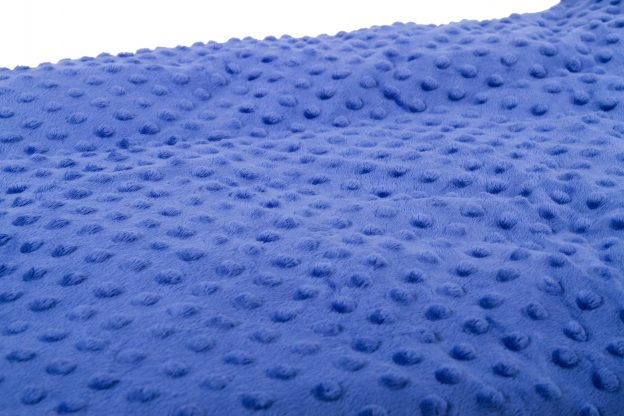
Therapy Tips  Weighted blankets have been shown to increase serotonin in the body. Serotonin is an important chemical that helps regulate mood and ease relaxation. It’s been shown that children with autism are low in serotonin. This could be one of the reasons why they see so much benefit from weighted blankets.
Serotonin is necessary to create melatonin, a chemical that tells your body when it’s time to sleep. Your body produces melatonin based on the timing of your sunlight exposure and uses that as a schedule to help your body know when it’s time to relax.
Weighted blankets have been shown to increase serotonin in the body. Serotonin is an important chemical that helps regulate mood and ease relaxation. It’s been shown that children with autism are low in serotonin. This could be one of the reasons why they see so much benefit from weighted blankets.
Serotonin is necessary to create melatonin, a chemical that tells your body when it’s time to sleep. Your body produces melatonin based on the timing of your sunlight exposure and uses that as a schedule to help your body know when it’s time to relax.
 There are quite a few studies that show that using DTP in the classroom can help improve children’s performance. One study found that children with ADHD improved their in-seat behavior, attention, and task completion while wearing a weighted vest.
Another study looked specifically at fine motor activities like writing and found that DTP had a positive effect on on-task behavior. It’s also been shown that children with autism specifically have better in-seat behavior when using DTP.
There are quite a few studies that show that using DTP in the classroom can help improve children’s performance. One study found that children with ADHD improved their in-seat behavior, attention, and task completion while wearing a weighted vest.
Another study looked specifically at fine motor activities like writing and found that DTP had a positive effect on on-task behavior. It’s also been shown that children with autism specifically have better in-seat behavior when using DTP.
 This may be an overall theme to all of the other benefits of weighted blankets. A lot of them stem from the fact that weighted blankets have been shown to reduce anxiety.
One study looked specifically at dental patients and used weighted blankets as a way to reduce their anxiety in a high-anxiety situation. The study showed that the weighted blanket caused physiological changes on the patients’ nervous system, helping them feel calmer at the dentist.
Another study found that even short periods of DTP brought about a reduction in sympathetic arousal, which generally means a calming-down effect. If anxiety is an issue for your child, a weighted blanket could be a good tool to have on hand.
This may be an overall theme to all of the other benefits of weighted blankets. A lot of them stem from the fact that weighted blankets have been shown to reduce anxiety.
One study looked specifically at dental patients and used weighted blankets as a way to reduce their anxiety in a high-anxiety situation. The study showed that the weighted blanket caused physiological changes on the patients’ nervous system, helping them feel calmer at the dentist.
Another study found that even short periods of DTP brought about a reduction in sympathetic arousal, which generally means a calming-down effect. If anxiety is an issue for your child, a weighted blanket could be a good tool to have on hand.
 If you’re raising a child with special needs, meltdowns are something that you will most likely have to deal with. Whether due to sensory overload or an unexpected change, meltdowns can be very difficult to deal with.
Fortunately, a lot of what we’ve already talked about can be related to meltdowns. Calming the nervous system, producing serotonin, and feeling a “hug” from the blanket can all help wind down a meltdown or even prevent it.
A related study found that the use of a sensory room led to significant reductions in distress and improvements of disturbed behaviors of individuals in an acute inpatient psychiatric unit. They specifically mention that those patients who “used the weighted blanket reported significantly greater reductions in distress and clinician-rated anxiety than those who did not.”
If you’re raising a child with special needs, meltdowns are something that you will most likely have to deal with. Whether due to sensory overload or an unexpected change, meltdowns can be very difficult to deal with.
Fortunately, a lot of what we’ve already talked about can be related to meltdowns. Calming the nervous system, producing serotonin, and feeling a “hug” from the blanket can all help wind down a meltdown or even prevent it.
A related study found that the use of a sensory room led to significant reductions in distress and improvements of disturbed behaviors of individuals in an acute inpatient psychiatric unit. They specifically mention that those patients who “used the weighted blanket reported significantly greater reductions in distress and clinician-rated anxiety than those who did not.”
 Struggling to get children with autism to change from one activity to another is a common theme among teachers and parents. In some special education classrooms, teachers have turned to weighted blankets to help make this transition easier. It works especially well when coming in from recess. The teachers give the children who need extra help a weighted blanket and dim the lights for five to ten minutes.
This is one of the practices that the University of Washington Autism Center helps implement in schools around the state of Washington. The strategy can be used at home for when your child comes home from school or inside from playing, or has just finished an activity and is overexcited. Since children with autism tend to do better with transitions when they have a routine, you can even work the weighted blanket into the routine. Let them know it’s time to transition when you get it out.
To find a weighted blanket or other weighted items to help your child, consult "Weighted Blankets: 13 Stores to Choose From." Pictured at the top of this post is a weighted blanket in a dotted minky fabric from Harkla.
Struggling to get children with autism to change from one activity to another is a common theme among teachers and parents. In some special education classrooms, teachers have turned to weighted blankets to help make this transition easier. It works especially well when coming in from recess. The teachers give the children who need extra help a weighted blanket and dim the lights for five to ten minutes.
This is one of the practices that the University of Washington Autism Center helps implement in schools around the state of Washington. The strategy can be used at home for when your child comes home from school or inside from playing, or has just finished an activity and is overexcited. Since children with autism tend to do better with transitions when they have a routine, you can even work the weighted blanket into the routine. Let them know it’s time to transition when you get it out.
To find a weighted blanket or other weighted items to help your child, consult "Weighted Blankets: 13 Stores to Choose From." Pictured at the top of this post is a weighted blanket in a dotted minky fabric from Harkla.
5 Research-Backed Benefits of Weighted Blankets and Vests
Weighted blankets and vests have been around as a therapy tool for a while now. Many parents have observed the calming effect they can have on children with autism and sensory issues. The science behind these weighted items is called Deep Touch Pressure (DTP). This is the term for the feeling of gentle, distributed weight on the body. You can get the benefits of DTP in a variety of ways. Hugging is one way that everyone can experience DTP. Weighted vests, blankets, stuffed animals, or lap pads are all ways to get the benefits of DTP. As long as there is gentle, distributed weight, there will be benefits from DTP. Research into the benefits of DTP can help you find new ways to help your child with weighted items. It may also be helpful in convincing your child's school to take these tools seriously and make them part of your child's behavior plan. The following are some areas on which research has focused.1. Promoting and Improving Sleep
 Weighted blankets have been shown to increase serotonin in the body. Serotonin is an important chemical that helps regulate mood and ease relaxation. It’s been shown that children with autism are low in serotonin. This could be one of the reasons why they see so much benefit from weighted blankets.
Serotonin is necessary to create melatonin, a chemical that tells your body when it’s time to sleep. Your body produces melatonin based on the timing of your sunlight exposure and uses that as a schedule to help your body know when it’s time to relax.
Weighted blankets have been shown to increase serotonin in the body. Serotonin is an important chemical that helps regulate mood and ease relaxation. It’s been shown that children with autism are low in serotonin. This could be one of the reasons why they see so much benefit from weighted blankets.
Serotonin is necessary to create melatonin, a chemical that tells your body when it’s time to sleep. Your body produces melatonin based on the timing of your sunlight exposure and uses that as a schedule to help your body know when it’s time to relax.
Nervous system changes
On top of the chemical changes, there are changes in the nervous system when using weighted blankets. Our nervous systems calm down when under the weight of a heavy blanket. This can be a major help for those who can’t fall asleep due to anxiety. The weight of the blanket also helps reduce restlessness during sleep. It is harder to move around while under a blanket of the right weight. The general rule is that the weight of the blanket should be 10 percent of the individual's body weight plus a pound or two.Insomnia
A weighted blanket could perhaps be the non-pharmaceutical answer to getting a solid nights sleep for those struggling with insomnia. One study found that not only did participants with insomnia feel like they got “a more comfortable, better quality, and more secure sleep,” but the data from tracking their sleep showed they got better sleep as well.2. Improving Focus in the Classroom
 There are quite a few studies that show that using DTP in the classroom can help improve children’s performance. One study found that children with ADHD improved their in-seat behavior, attention, and task completion while wearing a weighted vest.
Another study looked specifically at fine motor activities like writing and found that DTP had a positive effect on on-task behavior. It’s also been shown that children with autism specifically have better in-seat behavior when using DTP.
There are quite a few studies that show that using DTP in the classroom can help improve children’s performance. One study found that children with ADHD improved their in-seat behavior, attention, and task completion while wearing a weighted vest.
Another study looked specifically at fine motor activities like writing and found that DTP had a positive effect on on-task behavior. It’s also been shown that children with autism specifically have better in-seat behavior when using DTP.
Self-Stimulatory Behaviors
Weighted vests have been found to reduce self-stimulatory behaviors, also known as fidgeting or stimming. There are many reasons why a person might engage in self-stimulatory behavior, but one of the main reasons is that they are feeling sensory overload. Whether used in therapy or at home, a weighted blanket is a great addition to a sensory room. The extra weight adds a sensory input that allows people to feel their body. For those with sensory issues, not being able to feel where your body ends can be a challenge.Use in Long Sitting Situations
A lot of times, simply getting your child to sit still can be a struggle. Whether it’s for a presentation, assembly, movie, or just a car or bus ride, getting your child to sit calmly can often feel impossible. For these situations, a weighted blanket would be a great option. Not only would it help calm the nervous system and release serotonin, but the sensory input of the fabric could give your child something to play with for an extended period of time. While you could bring a weighted blanket with you wherever you go, this would be a good time to have a weighted lap pad on hand. Since you’ll be out and about, we’d recommend getting a blanket or lap pad that is easy to wash.3. Reducing Anxiety
 This may be an overall theme to all of the other benefits of weighted blankets. A lot of them stem from the fact that weighted blankets have been shown to reduce anxiety.
One study looked specifically at dental patients and used weighted blankets as a way to reduce their anxiety in a high-anxiety situation. The study showed that the weighted blanket caused physiological changes on the patients’ nervous system, helping them feel calmer at the dentist.
Another study found that even short periods of DTP brought about a reduction in sympathetic arousal, which generally means a calming-down effect. If anxiety is an issue for your child, a weighted blanket could be a good tool to have on hand.
This may be an overall theme to all of the other benefits of weighted blankets. A lot of them stem from the fact that weighted blankets have been shown to reduce anxiety.
One study looked specifically at dental patients and used weighted blankets as a way to reduce their anxiety in a high-anxiety situation. The study showed that the weighted blanket caused physiological changes on the patients’ nervous system, helping them feel calmer at the dentist.
Another study found that even short periods of DTP brought about a reduction in sympathetic arousal, which generally means a calming-down effect. If anxiety is an issue for your child, a weighted blanket could be a good tool to have on hand.
Obsessive-Compulsive Disorder
One of the common ways to help alleviate OCD anxiety is to improve serotonin production through pharmaceuticals. However, since weighted blankets have been shown to improve serotonin production, they can be used to help alleviate OCD anxiety as well. There are a lot of disorders that are related to low serotonin in which a weighted blanket could be useful, including depression, aggression, PTSD, and bipolar disorder.4. Calming Meltdowns
 If you’re raising a child with special needs, meltdowns are something that you will most likely have to deal with. Whether due to sensory overload or an unexpected change, meltdowns can be very difficult to deal with.
Fortunately, a lot of what we’ve already talked about can be related to meltdowns. Calming the nervous system, producing serotonin, and feeling a “hug” from the blanket can all help wind down a meltdown or even prevent it.
A related study found that the use of a sensory room led to significant reductions in distress and improvements of disturbed behaviors of individuals in an acute inpatient psychiatric unit. They specifically mention that those patients who “used the weighted blanket reported significantly greater reductions in distress and clinician-rated anxiety than those who did not.”
If you’re raising a child with special needs, meltdowns are something that you will most likely have to deal with. Whether due to sensory overload or an unexpected change, meltdowns can be very difficult to deal with.
Fortunately, a lot of what we’ve already talked about can be related to meltdowns. Calming the nervous system, producing serotonin, and feeling a “hug” from the blanket can all help wind down a meltdown or even prevent it.
A related study found that the use of a sensory room led to significant reductions in distress and improvements of disturbed behaviors of individuals in an acute inpatient psychiatric unit. They specifically mention that those patients who “used the weighted blanket reported significantly greater reductions in distress and clinician-rated anxiety than those who did not.”
5. Making Transitions Easier
 Struggling to get children with autism to change from one activity to another is a common theme among teachers and parents. In some special education classrooms, teachers have turned to weighted blankets to help make this transition easier. It works especially well when coming in from recess. The teachers give the children who need extra help a weighted blanket and dim the lights for five to ten minutes.
This is one of the practices that the University of Washington Autism Center helps implement in schools around the state of Washington. The strategy can be used at home for when your child comes home from school or inside from playing, or has just finished an activity and is overexcited. Since children with autism tend to do better with transitions when they have a routine, you can even work the weighted blanket into the routine. Let them know it’s time to transition when you get it out.
To find a weighted blanket or other weighted items to help your child, consult "Weighted Blankets: 13 Stores to Choose From." Pictured at the top of this post is a weighted blanket in a dotted minky fabric from Harkla.
Struggling to get children with autism to change from one activity to another is a common theme among teachers and parents. In some special education classrooms, teachers have turned to weighted blankets to help make this transition easier. It works especially well when coming in from recess. The teachers give the children who need extra help a weighted blanket and dim the lights for five to ten minutes.
This is one of the practices that the University of Washington Autism Center helps implement in schools around the state of Washington. The strategy can be used at home for when your child comes home from school or inside from playing, or has just finished an activity and is overexcited. Since children with autism tend to do better with transitions when they have a routine, you can even work the weighted blanket into the routine. Let them know it’s time to transition when you get it out.
To find a weighted blanket or other weighted items to help your child, consult "Weighted Blankets: 13 Stores to Choose From." Pictured at the top of this post is a weighted blanket in a dotted minky fabric from Harkla. 


